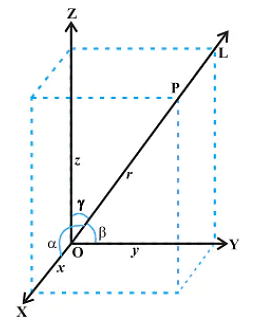Equation of the line of the shortest distance between the lines $\frac{x}{1} = \frac{y}{-1} = \frac{z}{1}$ and $\frac{x-1}{0} = \frac{y+1}{-2} = \frac{z}{1}$ is :
- $\frac{x}{1} = \frac{y}{-1} = \frac{z}{-2}$
- $\frac{x-1}{1} = \frac{y+1}{-1} = \frac{z}{-2}$
- $\frac{x-1}{1} = \frac{y+1}{-1} = \frac{z}{-1}$
- $\frac{x}{-2} = \frac{y}{1} = \frac{z}{2}$
The Correct Option is B
Solution and Explanation
$\frac{x}{1}=\frac{y}{-1}=\frac{z}{1}$

$\frac{x-1}{0}=\frac{y+1}{-2}=\frac{z}{1} $
$\frac{1-\lambda}{1}=\frac{-1-2 \mu+\lambda}{-1}=\frac{\mu-\lambda}{-2} $
$-2=3 \lambda+\mu $
$-1+\lambda=-1-2 \mu+\lambda $
$\mu=0 $
$ \lambda=-\frac{2}{3}$
Top Questions on Three Dimensional Geometry
- If A(2,1,-1), B(6,-3,2), C(-3,12,4) are the vertices of a triangle ABC and the equation of the plane containing the triangle ABC is $53x+by+cz+d=0$, then $\frac{d}{b+c}=$
- TS EAMCET - 2025
- Mathematics
- Three Dimensional Geometry
- If $(\alpha, \beta, \gamma)$ is the foot of the perpendicular drawn from a point $(-1,2,-1)$ to the line joining the points $(2,-1,1)$ and $(1,1,-2)$, then $\alpha+\beta+\gamma=$
- TS EAMCET - 2025
- Mathematics
- Three Dimensional Geometry
- If m:n is the ratio in which the point $\left(\frac{8}{5}, \frac{1}{5}, \frac{8}{5}\right)$ divides the line segment joining the points (2,p,2) and (p,-2,p) where p is an integer then $\frac{3m+n}{3n}=$
- TS EAMCET - 2025
- Mathematics
- Three Dimensional Geometry
- Let $\pi_1$ be the plane determined by the vectors $\hat{i}+\hat{j}, \hat{i}+\hat{k}$ and $\pi_2$ be the plane determined by the vectors $\hat{j}-\hat{k}, \hat{k}-\hat{i}$. Let $\vec{a}$ be a non-zero vector parallel to the line of intersection of the planes $\pi_1$ and $\pi_2$. If $\vec{b} = \hat{i}+\hat{j}-\hat{k}$ then the angle between the vectors $\vec{a}$ and $\vec{b}$ is
- TS EAMCET - 2025
- Mathematics
- Three Dimensional Geometry
Show that the following lines intersect. Also, find their point of intersection:
Line 1: \[ \frac{x - 1}{2} = \frac{y - 2}{3} = \frac{z - 3}{4} \]
Line 2: \[ \frac{x - 4}{5} = \frac{y - 1}{2} = z \]
- CBSE CLASS XII - 2025
- CBSE Compartment XII - 2025
- Mathematics
- Three Dimensional Geometry
Questions Asked in JEE Main exam
- The kinetic energy of translation of the molecules in 50 g of CO\(_2\) gas at 17°C is:
- JEE Main - 2025
- The Kinetic Theory of Gases
- Using the principal values of the inverse trigonometric functions the sum of the maximum and the minimum values of \(16((sec^{-1}x)^{2}+(cosec^{-1}x)^{2})\) is:
- JEE Main - 2025
- Inverse Trigonometric Functions
Consider the following sequence of reactions :

Molar mass of the product formed (A) is ______ g mol\(^{-1}\).- JEE Main - 2025
- Organic Chemistry
- A wire of resistance R is bent into an equilateral triangle and an identical wire is bent into a square. The ratio of resistance between the two end points of an edge of the triangle to that of the square is:
- JEE Main - 2025
- electrostatic potential and capacitance
In a Young's double slit experiment, three polarizers are kept as shown in the figure. The transmission axes of \( P_1 \) and \( P_2 \) are orthogonal to each other. The polarizer \( P_3 \) covers both the slits with its transmission axis at \( 45^\circ \) to those of \( P_1 \) and \( P_2 \). An unpolarized light of wavelength \( \lambda \) and intensity \( I_0 \) is incident on \( P_1 \) and \( P_2 \). The intensity at a point after \( P_3 \), where the path difference between the light waves from \( S_1 \) and \( S_2 \) is \( \frac{\lambda}{3} \), is:

- JEE Main - 2025
- electrostatic potential and capacitance
Concepts Used:
Three Dimensional Geometry
Mathematically, Geometry is one of the most important topics. The concepts of Geometry are derived w.r.t. the planes. So, Geometry is divided into three major categories based on its dimensions which are one-dimensional geometry, two-dimensional geometry, and three-dimensional geometry.
Direction Cosines and Direction Ratios of Line:
Consider a line L that is passing through the three-dimensional plane. Now, x,y and z are the axes of the plane and α,β, and γ are the three angles the line makes with these axes. These are commonly known as the direction angles of the plane. So, appropriately, we can say that cosα, cosβ, and cosγ are the direction cosines of the given line L.
